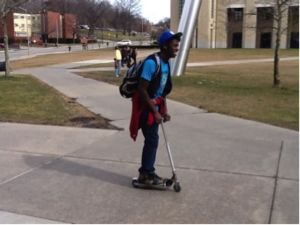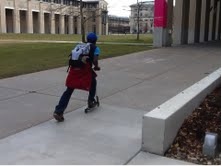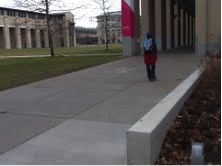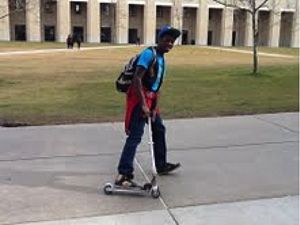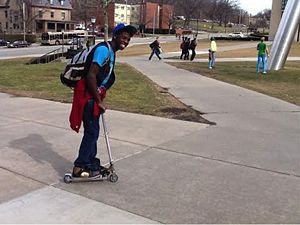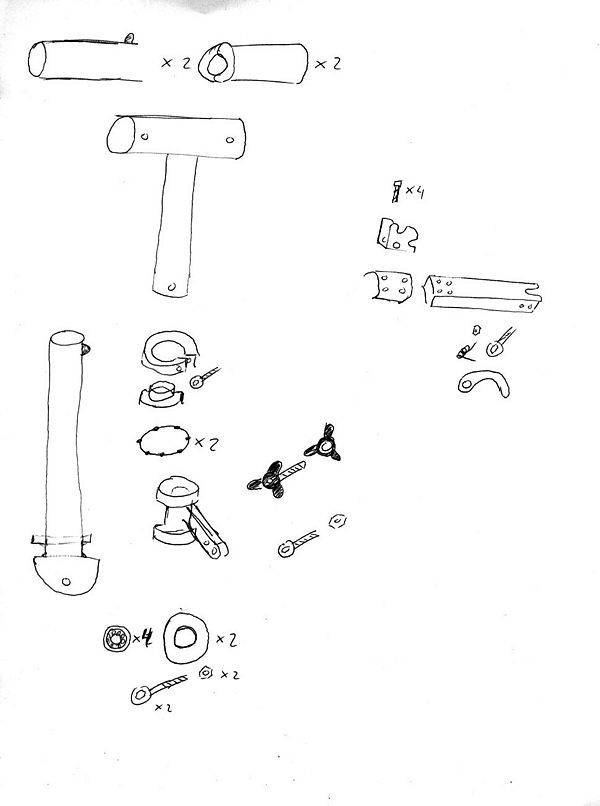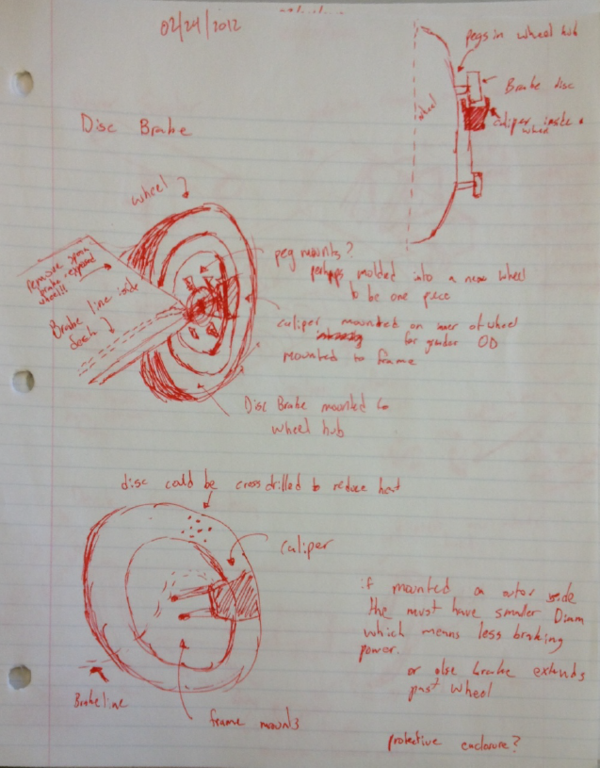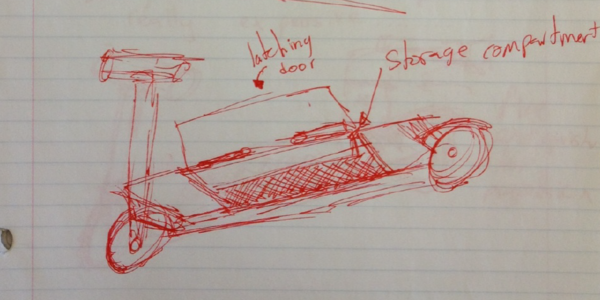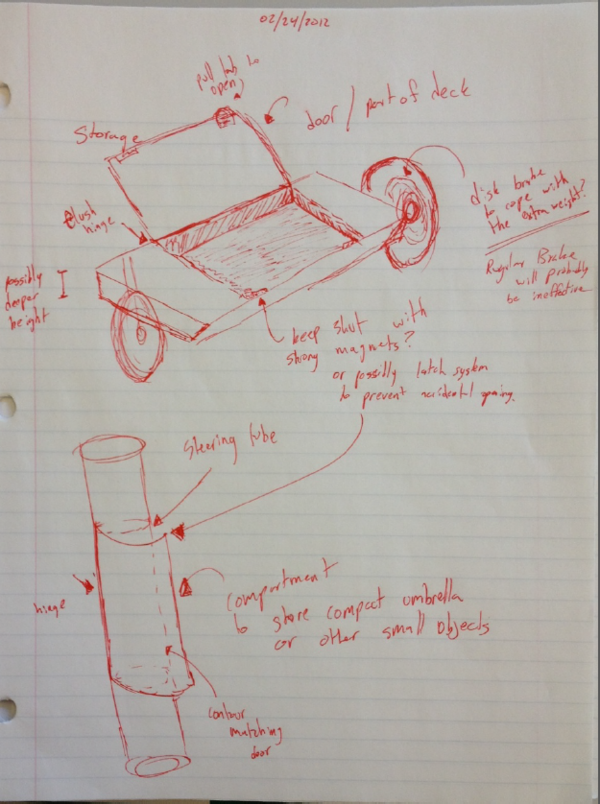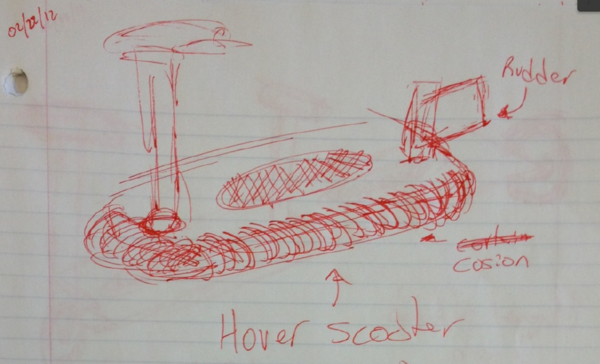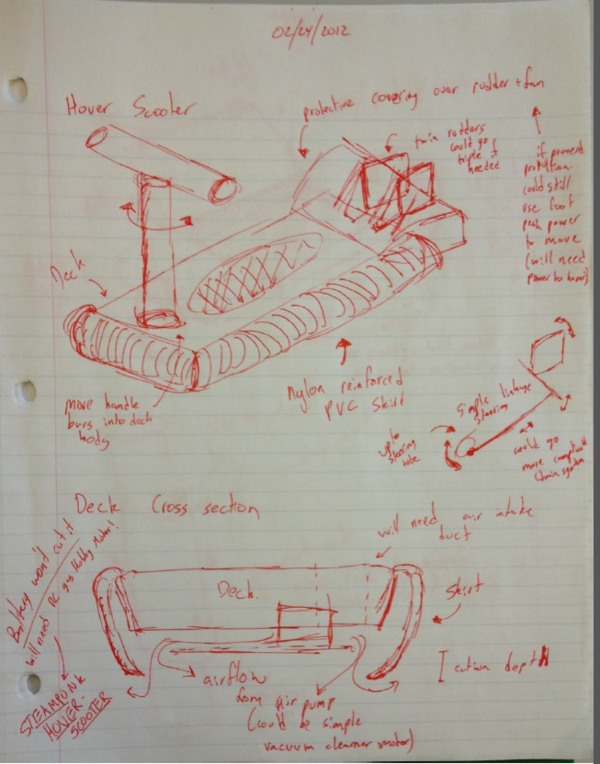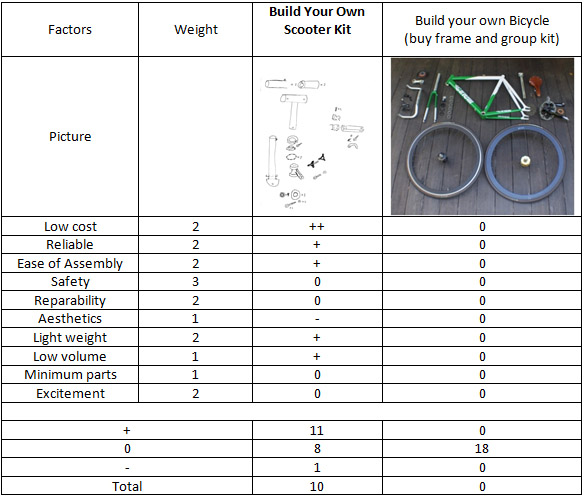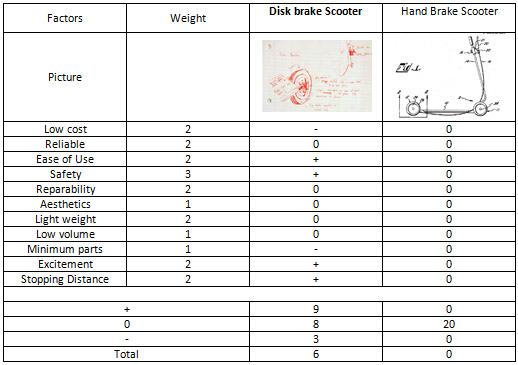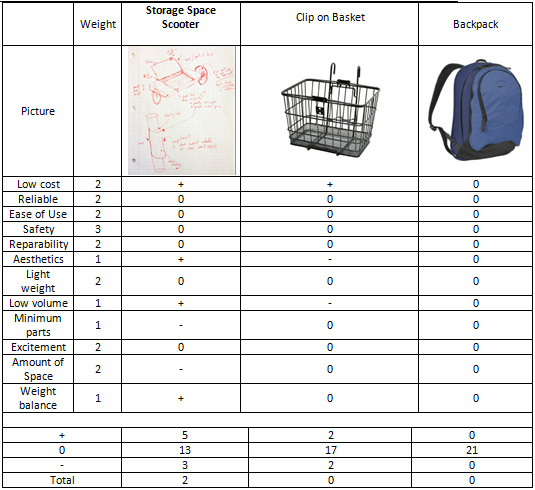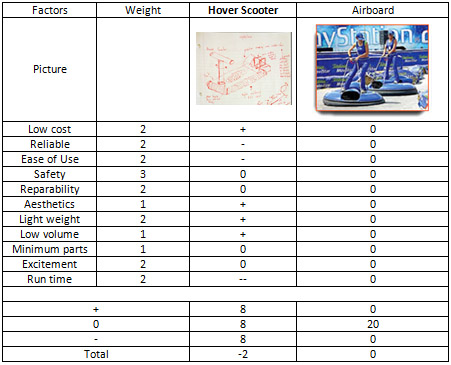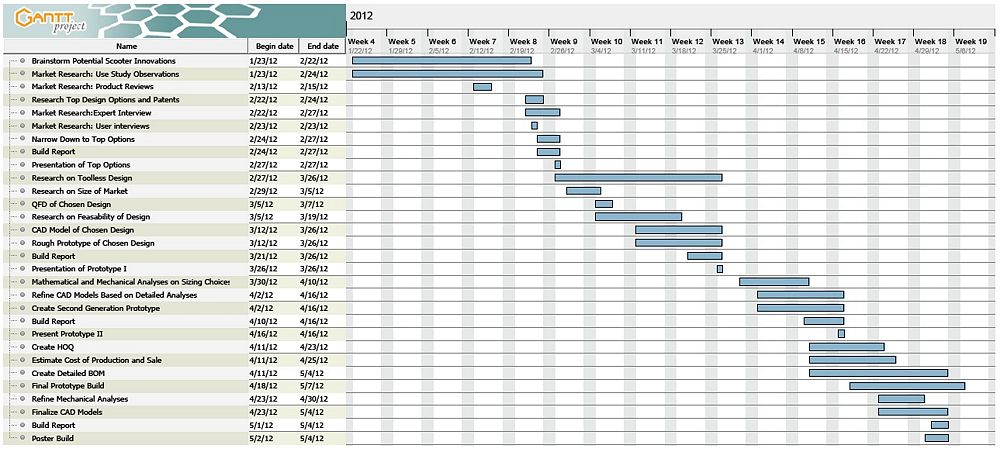Scooter opportunity
From DDL Wiki
Report 2: Market Research and Design Concepts
Contents |
Group Information
24-441 Spring 2012, Group 10
Claire Castleman: Team Leader
Elisha Clayton: Market Research Lead
Michael Serebrennikov: Sketching Extraordinaire & Design Concepts Lead
Mathew Swisher: Competitive Reviews & Prototype Analyst
Vedant Saraf: Stakeholders & Expert Interview Lead
Executive Summary
In Phase II of our design project, our team did extensive market research into the concerns of some of our key stakeholders. This research revealed several main priorities for our scooter redesign. Our competitors' customers' main concerns included the need for a reliable, lightweight scooter that could function as a form of transportation and also be fun to use. Our competitor was lacking in the abilities to store accessories, customize one's scooter, or easily repair the scooter. Often times the braking and steering systems were unreliable. Based on these insights, we brainstormed over 100 ideas for opportunities and narrowed these down to a top 4: the Build Your Own Scooter kit, improved disc brakes, improved storage on the scooter, or a hover scooter. Our team recommends going forth with our first idea, the Build Your Own Scooter kit. This product would address manufacturing and shipping concerns due to the necessary simplification and reduction of parts, as well as the decreased volume of the shipped product. It would address consumers' needs by allowing for easy repairs, customization, and add-ons. It would appeal to a wide age range of consumers. Children, college students, and adults could all enjoy building a scooter by themselves. It could easily maintain the low weight and high strength that were benefits of our current competitor's product.
Phase 2 Overview
Process Summary
To begin with, the group brainstormed on various ideas using the methods described in class. We focused on the utility of the product by keeping in mind the needs of the stakeholders. Creative ideas were discussed in order to add exciting functionality to the product, however many were not feasible to use, manufacture, assemble or sell. Possible design solutions were proposed, by sketches and descriptions for various designs. Then each idea was analyzed and a short-list containing the top ten choices were formed. A Pugh chart was formed using the short-list and ideas were ranked. The top items according to rank were ‘Build Your Own Scooter’, ‘Laser Tag Scooter’ and ‘Umbrella Scooter’.
In sync with analyzing designs, our group was involved in market research. We conducted an interview with a user who uses the Razor scooter regularly on the Carnegie Mellon campus. This allowed us to get important insight into the needs of the customers. We also analyzed product reviews on the internet, contacted the Razor Scooter USA Company for answering detailed questions on the product, and sent out a user survey. All these reviews contributed in a better understanding of the product and provided enough information for a detailed product research report.
Market Research
There are several market research techniques that we performed to help determine potential innovations for the Razor scooter. In gathering more detailed results based off our stakholders, we decided to research product reviews, conduct a survey, and perform a user interview and use study observation. From our analysis, we were able to narrow our 100 innovations list down to the top 4 potential designs for a newly developed Razor scooter. Our next tasks are to compare options and competitor products to help finalize our top design in moving further.
Major Stakeholder Needs
In all of our market research, we had to keep in mind the needs of major stakeholders in our potential product. Our stakeholder needs, updated from our initial report, are listed below.
Manufacturing
Manufacturers will care mainly about material and process costs. Some of their requirements are:
- Simple parts that can be mass produced
- A small number of unique parts
- Assembly with minimal effort
- Fast assembly time
- Low environmental effect of materials used
- Product/Material re-usability
Shipping
The shipping companies will be most concerned with spending the least amount of resources while transporting the maximum amount of product. Some of their requirements are:
- Maximum compressibility
- Low weight
- Low volume
- Reduce empty/wasted space
- Durable enough to withstand damage with minimal padding
Retailing
The primary goal of the retailer is to sell the product as quickly and for as high of a profit as possible. The retailers' requirements are:
- Appealing colors to customers
- Cheap product cost for maximal profit
- Easy to advertise
- Minimal store floor-space usage
- Efficient packaging for minimal storage space
Potential Consumers and their Concerns
Parents
Parents will be purchasing the product for their children to use. Their primary concerns will be:
- Safe
- Low cost
- Reliable
- Durable
- Something their kids will want and consider cool
- Low profile for storage
Kids
Children will use the product mainly as a toy, but it will also double as a status symbol. Their needs are:
- Fun
- Cool
- Light weight
- Trick friendly
College Students
College Students will use the scooter as a light and easy form of transportation around campus. The requirements for college students are:
- Portable
- Collapsible
- Durable
- Light weight
- Easy to carry/store
- Energy efficient
- Cheap
- Low profile for storage
- Easy to clean
- Versatility in various terrains
Product Reviews
After reviewing several product reviews from Amazon, Toys R Us, Target, and Wal-Mart, we were able to weigh various pros and cons of the Razor scooter. This part of the market research helped to outline various key criteria that customers find important in their scooter product such as durability, aesthetics, speed, weight, portability, and safety. Below are a few reviews from different purchasing companies that we highlighted in our research in choosing specific criteria for our future design. We wanted to make sure to recognize the pros and cons of our competitor's product.
Pros
"Attractive Design; Plain awesome; Lightweight; Quality Construction; Fun To Ride; Easy To Learn"
"Compared to a real pro scooter the price is amazing and the weight is awesome compared to the 20 pounds of other scooters"
"Quality Construction; Long lasting; Attractive Design; Easy To Learn; Lightweight; Fun To Ride"
"Great for price"
"Great for skateparks. get lucky bullet pegs on it and its just amazing. Get odi longnecks or some other grips for it, the razor grips are horrible and hurt
"Great scooter. Amazing. Awesome deal, too! Comes with one piece bars and a one piece deck-- VERY sturdy! I replaced the grips with ODI longneck grips and ODI barends, new griptape, new wheels, and it is amazing. GREAT FOR ANYONE INTERMEDIATE TO SUPER PRO. Beginner riders should sart with either an earlier razor or a razor pro because they shouldnt be handeling a scooter like this so early. I get tons of compliments on my scooter, with the fact i customized it and cuz its a razor ultra pro. The original Ultra Pro has bars that are a bit... well... WAY too high. These are the perfect height for me. Great deal and amazing scooter. HIGHLY RECCOMEND!!!"
"Tough scooter!"
Cons
"The steering column sometimes will move independently of the front wheel. Adjusting the hex nut where the two primary halves of the steering column connect does nothing."
"The back tire developed a large dent. My son is far from a professional user, and the jumps and tricks he does are very tame compared to a middle school or high school student. But he does go off low curbs. But he's ridden the same way for years on his previous Razor. The tires are clearly different on this newer model...they are translucent instead of opaque. And at some point, he must have gone off a curb, putting a large dent in the back tire. The tire should be able to support modest tricks by a modest rider, just as previous versions have."
"I bought this for my daughter and it is already broken. I asked her what happen and she said 'I was just riding it and it stopped turning'.....something inside the base of the handle bars has shifted out of place and she can no longer ride it :( we can try to fix it I suppose but after having the scooter for 11 days we should NOT have to be fixing it."
"Everything was good about it except one thing,Sometimes when I go from the sidewalk to the street I hit the gutter in between and when I go on it the bottom of the scooter scrapes the concrete and people can sometimes fall really easily."
"This is a very bad scooter compared to the old razors. The old razors were much lighter and stronger. After 4 months of hard riding it started to develop shake (not from the headset) and rode very low to the ground."
"Poor Clearance, heavy"
From these reviews, we were able to gather valuable information. The main areas of concerns are durability, entertainment, safety, user friendliness, and maintenance. By learning more of the consumers' wants, needs, and dislikes in the Razor scooter, we were able to apply this knowledge to factor in on what design prototype would be most feasible for interest and marketable in comparison to competitor products.
User Interviews
Another technique we chose to use for our market research is an user interview. The user is one of the most prominent sources of gathering information about the product. We chose to interview a first year college student studying Chemical & Environmental Engineering who uses the scooter on a daily basis to and from class. We received several good responses from the interview to help us move forward in narrowing our product design. The list of questions along with responses during the user interview are as follows:
Q1:What made you purchase the scooter?
A1:own three since they first came out. I like them as a kid.
Q2: Does it meet your needs? How do you use it? What purposes?
A2:Yes, its fast, convenient, portable, useful for getting to class to and from, its a hobby in my free time in between classes to just have fun
Q3: How did you first hear about the Razor scooter in particular?
A3: TV along with friends
Q4: How long have you had it?
A4: Right around the time it first came out in about 2000, I was one of the first kids
Q5: What made you choose this scooter over others?
A5: Brand really played a role
Q6: What do you like?
A6: Customize it, I put light up wheels, sparks, you can make it your own. Its different from skateboards and riding bikes, which are the usual
Q7: What dont you like?
A7: I really dont know what I dont like, but the height is kinda small because its mainly for kids and it kicks you in the leg
Q8: What do you use with your scooter (ipod, carrier, etc.)?
A8: I listen to music on my scooter, ipod, but i dont reallt put things on it because its small
Q9: What improvements would you want to make the scooter better?
Q9: Better handle bars for rideing, more safety measures especially when riding over cracks, make it cooler for sharp turns, better brake for steeper hills, more customizable parts.
Q10: Do you enjoy the Razor scooter?
A10: yes
From this interview, we were able to capture more detailed information about users' main concerns. Making the scooter more fun, useful, safe, and customizable were clearly strong opportunities. Therefore, we made sure to take these key criteria points into consideration when doing our design comparisons.
Use Study Observation
While observing the Razor scooter in use, we were able to pinpoint more unspoken concerns and potential interventions for future work. There are various areas of improvement within the scooter that can be further researched and analyzed to help determine its significance and feasibility in the scope of our project. Some key observations that were highlighted are shown below:
Observation #1: There is a concern with height and how we can make the Razor scooter accomodate various heights.
Observation #2: There is a concern with the wheels and the cracks in the pavement and how to create a smoother ride.
Observation #3: There is a concern with the distance that one push can get you and how we can maximize that distance.
Observation #4: There is a concern with making the scooter more fun, cool for unlimited tricks yet safe
Observation #5: There is a concern with the aesthetics of the scooter and how it can more customizable for individuality.
Expert Interviews
We chose to formulate a expert interview as well. We wanted to get a better perspective of the manufacturing side of the product. Therefore we contacted the Public Relations and Marketing staff of the Razor company to receive any further details on the Razor scooter. The responses are still pending, but the questions we chose to ask specifically are as follows:
1) What is your target or most profitable demographic?
2) What are the needs of your stakeholders?
3) What do you hear as praises and complaints of your product?
4) What are some future directions are you leading towards?
5) What potential innovations are you currently working on?
6) What marketing strategies do you have for selling your product?
7) What tips can you provide our design group in improving a potential prototype?
Survey Results
We conducted a survey to determine the most valuable features of the Razor scooter. We surveyed a random selection of colleagues who have all once owned or experienced riding a scooter at one point in their lives. The survey was very brief and concise for more direct responses. We asked the following two questions,
1) Have you ever owned or played with someone else's Razor scooter or knockoff?
2) What are the top 3 features that you would improve on the Razor Scooter?
- The steering
- Better wheels
- Lighter weight
- Easier to carry
- Storage for items
- Maintenance
- Trick and stunt friendly
- Customizable
- Multiple use
- Crazy special features (novelty scooter)
- Other:
After analyzing the final results, we found that the top features that call for the most improvement on the scooter are the brakes, steering, wheels, customizability, and lighter weight. Over 50% of the data collected chose these options as design features to take into account when developing a better prototype. This market research technique really helped with the scooter design breakdown in isolating the most valuable attributes of the consumer needs.
Design Concepts
Following the brainstorm list analysis, the top four concepts were chosen based on the main opportunities we saw for a new product from insight gained from market research. These top opportunities are the Build-You-Own-Scooter kit, the disk break innovation on the rear wheel, a scooter with increased storage capacity, and a hover scooter. The Build-You-Own-Scooter kit and the redesigned brake options were chosen based mostly on comments found in the negative user reviews. These are summarized in the user reviews section. The storage scooter was chosen based mostly on user observations and the user interview. The hover scooter was chosen as a novelty entertainment item and because it would be awesome.
Build Your Own Scooter
The Build Your Own Scooter kit involves the end user putting the scooter together from a box of parts, rather than buying a built scooter. This kit would be more attractive to all the stakeholders as it would be cheaper to manufacture, ship, and sell, while offering greater customizability to the end user. The kit could incorporate various size wheels, and other different options for the user to experiment with. The kit would also have a much higher repairability factor since there would be instructions and replacement parts available. Repairability and installation would also be easier due to the necessary simplification of the scooter design, and the possibility of making construction tool-less or nearly tool-less.
Hand or Foot Operated Disk Brakes
Through market research, the current brake design has proved to be ineffective, and most users just ignore it and stop the scooter with their foot rather than the brake supplied. The disk brake offers the user a much more effective and safer means of stopping the scooter. A mounted disk and caliper on the rear wheel would provide the additional braking power to bring the scooter to a stop. The brake could be implemented via a cable attached to a hand lever on the handle bars, or by a button pressed with the user's foot. Disc brakes would also prevent the wheels from being damaged during braking, extending the life of the product.
Improved Storage Capabilities
The improved storage scooter would provide the user with various locations in the scooter to store small items such as books, phones, snacks, umbrellas, etc. One possible location for storage is located in the deck, and is accessible via a door on the top surface. Another location is on the steering tube, and is accessible via a door on the tube itself. This spot is good for items such as umbrellas.
Hover Scooter
The hover scooter is a novelty entertainment design that uses a vacuum cleaner motor and a side skirt to provide lift and make a sort of hovering effect. Forward motion would still be created by kick power. Since there are no longer any wheels, the steering would be done with a rudder on the back connected to the handlebars with a lever system running through the deck.
Competitor Products
Build Your Own Scooter Competition
One possible product that we analyzed against competitor products was the concept of a build your own scooter kit. The most similar competitor to this product is people building their own bicycles. This is similar because both provide the users with the experience of building a small unpowered vehicle. Building your own bicycle is treated as the datum for the analysis. Both provide excitement and good repairability. However the scooter would be significantly less expensive since there is no need for gears etc. The advantage of the bike is that there is grater customization available as there are a number of manufacturers selling parts with standardized connections. The lower cost and simpler assembly would appeal to a younger set of users than the bicycle, most likely high school and collage students.
Brake Competition
The second product opportunity that we analyzed was the incorporation of disk brakes into the design of the scooter. These disk brakes could be hand or foot operated. As a datum we used a design from a patent for a scooter with a hand brake. While the inclusion of a disk brake would cost more than the design in the patent and contain more parts, it would provide significant benefits in safety, ease of use of the scooter, and in the stopping distance of the scooter. These benefits would help all of the users of the product.
Storage Competition
The next product opportunity that we analyzed was the idea of a scooter with extra storage space in the deck and head tube. We used a backpack as a datum for this analysis because it is a common way that people can use to transport supplies while riding a scooter. Another competitor for transporting supplies is a clip on basket. Our design for facilitating the transport of supplies is more integrated into the scooter than either of the other options. The integrated storage keeps the weight balanced during use and does not interfere with the motion of the rider and does not take up as much space as a separate backpack or basket, since it uses the wasted space in the deck and head tube. Additional it is more aesthetically pleasing to not have a backpack or basket attached to or used with the scooter. The downsides of this integrated storage space is that it provides less space than the competitor product and that it increases the number of parts in the scooter. Overall this product only has a slight advantage over the competitor products, however it does meet the specific needs for those who regularly need take small items with them while using the scooter. The compartments could hold pencils or small note pads which would be useful for students.
Hover Competition
The datum that the hover scooter is being compared against is the Airboard. The air board is a hovering disk that the user stands on. Unlike the hover scooter, the Airboard is not propelled by the user pushing off of the ground, but by a wheel attached to the back which can be made to contact the ground. The advantage of the hover scooter is that it is likely to be cheaper and smaller than the Airboard, however it would not be able to run as long as the Airboard due to power/fuel constraints. The hover scooter is more novel than the Airboard since you are self propelled and who has never dreamed of having a hover board. Unfortunately the hovering design is fairly difficult to build and not a practical method for transportation. The users of this design would have to be older, both because of the products expense and because of safety concerns.
Conclusions
In using the information gathered from our market research techniques, we were able to finalize an opportunity for our scooter product. It is important that we not only cater to the interests of the consumer, but also weigh in the scope of the project in terms of time constraints, resources, capabilities, costs, and feasibility. Using data from our research, we determined that the main areas of improvement for the scooter are brake effectiveness and safety, easier repairs, and better customization. The elements we should consider keeping from the Razor scooter are its light weight and moderate durability. After analyzing our top ideas, we decided the Build Your Own scooter kit best fit all of these criteria. We will be mainly determining ways to make the scooter design simpler and, as an additional feature, customizable. We are planning to look into customizable, replaceable, less complex components such as wheels (big, small, or light-up), handle bars (cushioned, colorful), decks (wide, small, storage), brakes (disc, spoon), and cool attachments for different activities (chalk dispenser, water gun, exercise, cleaning).
Hypothetical User Scenario
Jack Sparrow is an 13-year-old 7th grader. He enjoys playing outdoors with his friends, but also is in touch with his engineering side and enjoys figuring out how things work. One of his favorite outdoor toys is his kick scooter; however, it is prone to damage, and due to a lack of instructions it is nearly impossible to repair. Its overly-complicated mechanisms also make it risky to take apart. Apart from the repairability factor, the fixed configuration limits its use to roads and sidewalks. With the Build-Your-Own scooter kid, not only can Jack repair his scooter, he can also swap out components such as different brake components, and beefier wheels. This will allow him to use his scooter everywhere without having to worry about getting stuck.
Next Steps
In the next phase of our project, we will begin conceptualizing a design for our product. We will think of the product in more concrete terms, begin doing mechanical, mathematical, market, and cost analyses, and have an initial prototype by the end of the phase. Below is a Gantt chart showing our proposed progress to the end of the project.
Appendix A: List of 100+ Brainstormed Ideas
- smoother ride
- better wheel technology
- spherical wheels for omnidirectional motion
- collapsible wheels
- greater energy output with less input
- easier collapsibility
- lighter
- more portable
- adding a carrier for accessories (something to carry items)
- adding more telescoping rods for taller riders
- greener material usage
- wider deck for comfort
- multiseasonal scooter
- ski scooter
- winterized scooter
- heated wheels
- anti lock breaks
- hand break wiring system to back wheel
- turning system
- brake system that doesn't rub against the wheel so much
- better folding mechanism
- no more release buttons
- bigger release buttons
- safety latches
- trick friendly
- better braking mechanism
- expandable foot deck
- taller tube
- claw break for spherical wheels
- foot operated disc brakes
- extra padding at the bottom of wheel to reduce wearing
- additional safety pieces to components
- cleaning attachments on the back wheel (mop, broom)
- strap for easy carrying
- foot latch to release and hold (fold in and fold out) the foot deck when going in and out of buildings
- roll the folded scooter like a cart or suitcase when in buildings
- something to stop the deck hitting against your leg when carrying it
- integrated backpack carrier
- stronger wheels
- inflatable wheels
- sturdier steering mechanism
- more clearance
- electronically adjustable steering
- speed sensitive steering
- Bluetooth on scooter
- Wifi on scooter
- Mobile hotspot scooter
- Power generator scooter
- Charge devices from mechanical power
- Carrier for water bottle or cell phone
- Kickstand
- Scooter that can tow things
- Drop down safety wheels
- Hover scooter
- Jet scooter
- Water ski scooter
- Floating scooter
- Hockey stick integratible scooter
- Ice skate scooter
- Headlight
- Glow in the dark scooter
- Scooter with leash attachment
- Training wheels on scooter
- Speakers integrated
- Off road scooter with huge wheels
- Laser tag scooter
- Paintball scooter
- Headphone integrated wrapping mechanism
- Scooter with kicking attachment for kickball or beating up little kids
- Customizable decals
- Kit of decorations for scooter
- Build your own scooter
- Bumper scooters
- Pogo stick/scooter combo
- Make it easier to disassemble or repair/simplify design
- Scooter/hang glider combo
- Gps on scooter
- ekg scooter
- heart rate monitor scooter
- integrated track your workout system
- variable resistance for workouts
- scooter sled
- laptop carrier on scooter
- umbrella scooter
- solar panel scooter
- sand scooter
- fan on that scooter that runs on generated energy
- scooter that can sell back energy grid
- wind-powered scooter
- scooter that can carry your pets
- scooter that carries pet toys
- water gun scooter
- sprinkler scooter
- scooter lawn mower w/ all-terrain wheel on front
- shovel scooter
- leaf blower scooter
- snow blower scooter
- weed whacker scooter
- scooter storage compartment in foot deck
- chair scooter
- locking mechanism
- scooter w/ sail
- tank scooter
- tandem scooter
Appendix B: Patent Search
Mobility Scooter/Lawn Mower Attachment
References
- Customer Reviews: Razor A2 Kick Scooter
<http://www.amazon.com/Razor-A2-Kick-Scooter/product-reviews/B000ODZBG6>
- Razor
- Razor A2 Scooter (Blue) - 13003A2-BL
<http://www.buydig.com/shop/product.aspx?sku=RZR13003A2BL>
- Razor A2 Kick Folding Scooter: Blue - Razor - Toys "R" Us
<http://www.toysrus.com/product/index.jsp?productId=2401181>
- AIRBOARD
<http://www.arbortech.com.au/view/airboard>
- Backpack Picture
<http://www.plunderguide.com/wp-content/uploads/2006/11/nike-core-backpack.jpg>
- Clip on Basket Picture
- Bike Kit Picture
<http://www.thirdraildesignlab.com/rimages5/crook3_extrusion.jpg>
